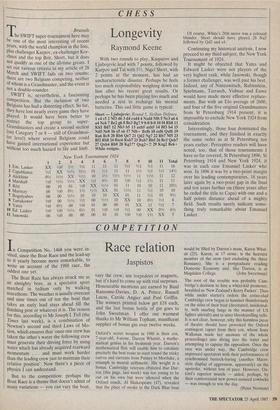CHESS
Longevity
Raymond Keene
Brussels hehe SWIFT super-tournament here may be one of the most interesting of recent years, with the world champion in the lists, plus challenger Karpov, ex-challenger Kor- chnoi and the top Brit, Short, but it does not qualify as one of the all-time greats. I set out various criteria in my article of 28 March and SWIFT fails on two counts: there are two Belgians competing, neither of whom is a Grandmaster, and the event is not a double-rounder.
SWIFT is, nevertheless, a fascinating competition. But the inclusion of two Belgians has had a distorting effect. So far, they have lost nearly every game they have Played. It would have been better to restrict the top group to super- Grandmasters and create a second section (say Category 7 or 8 — still of Grandmas- ter level) where several Belgians could have gained international experience but Without too much hazard to life and limb. With two rounds to play, Kasparov and Ljubojevic lead with 7 points, followed by Karpov and Tal with 51/2. Nigel Short, with 2 points at the moment, has had an uncharacteristic disaster. Perhaps he feels too much responsibility weighing down on him after his recent great results. Or perhaps he has been playing too much and needed a rest to recharge his mental batteries. This sad little game is typical: Short — Ljubojevic: Round 5, Sicilian Defence. 1 e4 c5 2 Nf3 d6 3 d4 cxd4 4 Nxd4 Nf6 5 Nc3 a6 6 a4 Nc6 7 Be2 g6 8 Be3 Bg7 9 0-0 0-0 10 f4 RbS 11 Khl Bd7 12 Nb3 b5 13 axb5 axb5 14 B13 b4 15 Nd5 Ne8 16 e5 e6 17 Nf6+ Bxf6 18 exf6 Qxf6 19 Ra6 Rc8 20 Rb6 Qe7 21 Qd2 Ng7 22 Rb7 Nf5 23 Bf2 RbS 24 Bxc6 Rxb7.25 Bxb7 Bb5 26 Rd Qxb7 27 Qxb4 Rb8 28 Kgl?? Qxg2+!! 29 Kxg2 Bc6+ White resigns.
New York Tournament 1924
1 2 3 4 5 6 7 8 9 10 11 Total
1 Em. Lasker
XX
1/20
11/2 1/21 11 11 11
1/21'
1/21 1/21 11 16 2 Capablanca
1/21
XX
11/2V2 1/21/2
01 1/21 11 11 11/2
1/21 1/21
141/2 3 Alekhine
01/2
1/21/2 XX 1/21/2 10 11/2
1/21/2
1/21/2 11
1/21/2
11 12
4 Marshall 1/20
1/21/2
1/21/2
XX
1/21
01/2 01 1/20 1/21 11/2 11 11 5 Reti 00 10 01
1/20
XX 1/21/2 01 11 10 10 11
101/2 6 Maroczy
00
1/20
01/2 11/2
1/21/2
XX 01 1/21/2 11 1/21 10 10 7 Bogolyubov 00 00 1/21/2 10 10 10 XX 01 11 1/21 01 91/2
8 Tartakower
1/20 00 1/21/2 1/21 00
1/21/2
10 XX 10
01/2
1/21 8
9 Yates
1/20 01/2 00 V-20 01 00 00 01 XX 11
1/21
7
10 Ed. Lasker
1/20 1/20 1/21/2 01/2 01 1/20
1/20
1/21 00 XX 01/2 61/2
11 Janowski
00
1/20
00 00 00 01 10 1/20 1/20 11/2 XX 5 Of course, White's 28th move was a colossal blunder. Short should have played 28 Na5 followed by Qd2 and c4.
Continuing my historical analysis, I now proceed to my third subject, the New York Tournament of 1924.
It might be objected that Yates and Edward Lasker were not players of the very highest rank, while Janowski, though a former challenger, was well past his best.
Indeed, any of Nimzowitsch, Rubinstein, Spielmann, Tarrasch, Vidmar and Euwe would have made more effective replace- ments. But with an Elo average of 2600, and four of the five original Grandmasters from St Petersburg 1914 present, it is impossible to exclude New York 1924 from consideration.
Interestingly, those four dominated the tournament, and they finished in exactly the same order as at St Petersburg ten years earlier. Perceptive readers will have noted, too, that of those tournaments I have so far covered, St Petersburg 1896, St Petersburg 1914 and New York 1924, it was in each case Emanuel Lasker who won. In 1896 it was by a two-point margin over his leading contemporaries, 18 years later again by a two-point gap in the final and ten years further on (three years after he ceded the title to Capa) with one and a half points distance ahead of a mighty field. Such results surely indicate some- thing truly remarkable about Emanuel Lasker.


































































 Previous page
Previous page